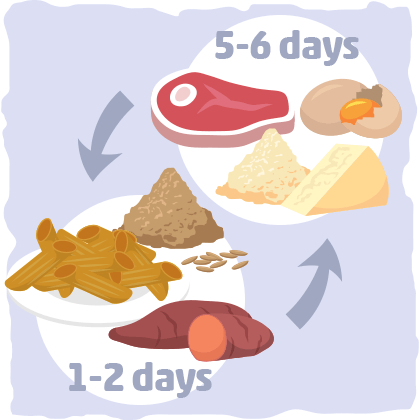To follow a ketogenic diet properly, you must restrict daily carbohydrates to around 20-30g of net carbs. This simple rule should be followed by everyone who is on a ketogenic diet, but there is one exception — athletes.
By “athletes” I mean anyone who is doing high-intensity type training multiple times a week. During high-intensity exercise, the body relies on glucose for fuel rather than fat.
To provide our muscles with the sugar they need to perform high-intensity training, we must supplement with carbs by implementing the cyclical ketogenic diet or the targeted ketogenic diet.
Cyclical Ketogenic Diet or Targeted Ketogenic Diet? Which One Should I Use?

The cyclical ketogenic diet devotes one to two FULL days of high carbohydrate consumption in order to fully refill muscle and liver glycogen stores. This means that cyclical ketogenic diet is not for those who are not able to perform the necessary amount or intensity of training.
For example, this diet variation is not recommended for low to moderate intensity trainers and exercise beginners because they most likely will not be able to fully deplete their glycogen stores and get back into ketosis if they follow the cyclical ketogenic diet. For this reason, if you’re a beginner or intermediate trainer or do ultra-endurance exercise, then a Targeted Ketogenic Diet is the best way for you to use carbohydrates as a performance enhancing tool.
On the other hand, if your rigorous training schedule contains high-intensity workouts that deplete your glycogen stores, enabling you to get back into ketosis each week, then the cyclical ketogenic diet is for you.
The primary purpose of the cyclical ketogenic diet is to use carbs as a tool to maximize muscle growth and exercise performance, while you also get the benefits of the standard ketogenic diet. The downside, however, is that you might gain some body fat with that extra muscle mass.
What is the Cyclical Ketogenic Diet (CKD) Exactly?
The standard format for a cyclical ketogenic diet is 5-6 days of ketogenic dieting and 1-2 days of high carb eating.
Others have also experimented with 2 week cycles, where 10-12 days are of ketogenic nature and 3-4 days are carb loading. The 2 week split has also had good results, but it doesn’t fit around everyone’s schedules as neatly.
The primary goal here is to temporarily switch out of ketosis to refill muscle glycogen, in order to sustain training performance in the next cycle.
If you are on a ketogenic diet for health reasons (hyperinsulinemia or hypertension), you may find the cyclical ketogenic diet unworkable as the hormonal response can trigger health symptoms that are being treated by a low carbohydrate diet.

Since the goal of a cyclical ketogenic diet is to completely deplete muscle glycogen – a proper workout schedule is needed for optimal results. A good workout plan example would be:
- Monday/Tuesday – Full body split. Monday could be legs and abs, and Tuesday could be chest, back, and arms.
- Friday – Full body, high rep depletion workout.
The amount of training to completely deplete your glycogen is dependent on the amount of carbs you had in your carb up phase. If low rep, heavy weights are being used, then 2-3 sets should be necessary. Conversely, if high rep, moderate weights are being used, you would need to do 5-6 sets.
How do I do the Cyclical Ketogenic Diet?
The low-carb portion of the cyclical ketogenic diet is identical to that of a Standard Ketogenic Diet. The nutrition is as follows:
- Calories for gaining mass: 18 calories per pound of body weight.
- Calories to lose weight: 12 calories per pound of body weight.
- Calories to maintain weight: 15-16 calories per pound of body weight.
- Carbohydrates: 30g or less per day. The fewer consumed, the faster you enter ketosis – this is more critical, as you only have 5-6 days of low carb.
- Protein: During the first 3 weeks eat 0.9g per pound lean mass or 150g, whichever greater. Afterward, set for your goals (1.0-1.2).
- Fats: Remainder of caloric needs.
After you’ve depleted glycogen stores and are in ketosis, you are ready for the carb-load portion of the Cyclical ketogenic diet.
Beginning the Carb-load and Getting into Cyclic Ketosis

To gear yourself toward an anabolic state, you will want to begin your carb loading 5 hours prior to your final workout. At this time, 25-50g can be consumed, along with protein and fats to begin higher production of liver enzymes.
1-2 hours before the final workout, a combination of glucose and fructose is recommended to refill the liver glycogen. 25-50g is a good place to start, and you can add more as needed.
The Carb-load
Most commonly, people just consume whatever they want during their carb-loads. Although quite haphazard, it still provides results. For those of us who want a more scientific approach, I will go through the guidelines for proper nutrient intake while doing a carb load.
Nutrient Intake
Your own experimentation is the best thing to recommend here, but I will provide you with some guidelines to help:
- First 24 hours: Carbohydrates will make up 70% of your total caloric intake. 15% protein, and 15% fats split evenly. Higher GI foods can be consumed, but it is best to stick with whole food carbohydrate sources rather than processed foods.
- Second 24 hours: 60% carbs, 25% protein, 15% fats. Lower GI foods should be consumed.
If you are not sure what Low GI and High GI foods are exactly and would like more precise guidance, read our recent article on What To Eat on The Cyclical Ketogenic Diet. It will clear up any questions you may have regarding what foods to eat and what is going on inside your body during the cyclical ketogenic diet.
Re-entering Ketosis After Carb Up
Emptying the store of glycogen in the liver will ensure your merry way to ketosis. The easiest and most foolproof method to do this? Simply follow these steps.
- Day 1: Do not eat after 6pm.
- Day 2: Wake up and perform HIIT or intense weight training on an empty stomach. Begin strict ketogenic diet with 0-2% carb intake. The combination of high-intensity exercise and a strict ketogenic diet will help deplete glycogen stores so that you can get into ketosis more rapidly.
- Day 3: Wake up and perform MISS (medium intensity steady state) or medium intensity weight training on an empty stomach. Return to normal ketogenic diet with 3-5% carb intake.
- Optional: consume MCTs for an extra ketone boost.
How Long Until I Am Back in Ketosis?
Everyone will get back into ketosis at different rates after their last high-carb meal. How long it takes you to get back into ketosis depends on many factors, including:
- How keto-adapted you are. The longer you have been on a ketogenic diet, the more your body is adapted for this. If you’ve been on it for a year, you will find it much easier to enter ketosis after a carb re-feed than say someone that has done it for a month.
- How much exercise experience you have. The more you train, the easier it will be to enter ketosis. This is mainly due to the fact that trained individuals can work out for longer periods of time at higher intensities than untrained individuals. Because of this, people with more exercise experience can deplete their glycogen stores and start burning ketones more quickly.
- How much high intensity exercise you do. High-intensity resistance training and conditioning will provide better results than aerobic training. Aerobic training will not deplete your glycogen stores nearly as much as a high-intensity workout.
- What you eat during your carb re-feeds. The better your carb choices (for example, eating mostly lower GI carbs like legumes, fruit, root vegetables, and unrefined grains), the easier it will be to re-enter ketosis.
- How consistent you are with the diet. The more consistent you are with your cyclical ketogenic diet (proper carb ups, not cheating, etc.), the easier it will be to come back to ketosis – and your body will adapt more efficiently after each refeed cycle.
Although there are some genetic and lifestyle factors that affect ketosis that may not be under your control, this list consists of every variable you can adjust to get back into ketosis more quickly after your refeeds. However — an important question still remains — is this dietary approach really worth the extra effort?
What the Science Says About Cyclical Ketogenic Diets
The research literature on cyclical ketogenic diets is scarce. However, there are two 2017 research studies that provide us with evidence that combining the ketogenic diet with carbohydrate re-feeding is a good idea for athletes.
In one study, twenty-five college-aged men were divided into a ketogenic diet group and a western diet group for ten weeks. After the ten weeks, the ketogenic dieters were put on the western diet for a week.
The results are fascinating. Not much difference was found between the two groups in the first ten weeks; however, the ketogenic diet group experienced a significant increase in lean body mass and power output on the Wingate Power Test (cycling at max intensity for a short period of time) after one week on the western diet. The same improvements were not found in the western diet group.

In the other 2017 study, researchers looked at the effects that a low carbohydrate diet, a high carbohydrate diet, and a periodized high carbohydrate diet (similar to a cyclical ketogenic diet) had on elite race walkers. The results confirm many suspicions that a strict low-carbohydrate diet can hurt performance at higher intensities, but what happened to the race walkers who were on the periodized high carbohydrate diet? They experienced a significant improvement in performance.
Although these two studies are not testing the same cyclical ketogenic diet schedule that we are proposing in this article, they provide evidence that you can combine the ketogenic diet with a high-carbohydrate diet to improve athletic performance and body composition. However, you don’t have to follow the diets that these studies used to get these results. All you have to do is follow the cyclical ketogenic diet by depleting glycogen stores, getting into ketosis, and then replenishing glycogen stores with a carb refeeding day or two. This way you get the benefits of keto-adaption, ketones, and carbohydrates.
But don’t forget — this diet is only meant for experienced trainers who regularly exercise high-intensities. How do you know if you fit into this category? We’ve provided a simple guide below so that you know exactly what we mean by “high-intensity.”
How Much is High Intensity?

Typically anaerobic exercises with repeated intervals that use bursts of strength will be considered high intensity. This type of exercise training increases energy demands of the body to the point where the cells have to start burning glucose for fuel.
How do you know when this happens? When you start huffing and puffing out of your mouth during exercise. This is an indication that your body is starting to burn more sugar than fat, which is what you want to happen so that you can deplete your glycogen stores and get into ketosis.
Here are some examples of high-intensity training vs. low-intensity exercise:
High Intensity:
- Low reps with weights done above 80% of your one rep maximum.
- Sprinting or wrestling.
- Circuit training (CrossFit courses).
Low Intensity:
- High reps with weights below 80% of your one rep maximum.
- Jogging or marathon running.
- Yoga
It is also important to realize that the cyclical ketogenic diet should NOT be used to improve your endurance limit; rather it should help you overcome strength barriers. Carb loading to get 2 more reps of your 15+ rep set is not a good time to use this, it should be used to get 2 more reps out of your 6-rep max set.
Putting It All Together
If you are on a standard ketogenic diet and do high-intensity exercise regularly, then you may benefit more from a cyclical ketogenic diet. With this dietary approach, you will be able to combine the benefits of burning ketones with having enough sugar available to improve performance, strength, and muscle gain.
The most common cyclical ketogenic diet format is 5-6 days of a standard ketogenic diet with 1-2 high-carb refeeding days. During the ketogenic diet phase of the cycle, make sure you do fasted high-intensity training to deplete your glycogen stores and push your body into ketosis more rapidly.
During your carbohydrate refeed, it is best to consume complex carbohydrates from whole food sources as high GI foods can impair your ability to get back into ketosis. On the first day, we recommend that you get at least 70% of your calories from carbohydrate sources like potatoes, yams, carrots, bananas, pineapples, raisins, and white rice. During the second day, it is best to decrease your carbohydrate intake by 10% and eat lower GI carbohydrates like whole grains, peas, blueberries, lentils, and black beans.
After your carb re-feed, focus on depleting your glycogen and increasing your ketone levels again and repeat the cycle — that’s it. By implementing this dietary strategy, you will reap the benefits of a high-carbohydrate diet and a ketogenic diet at the same time.
However, if you don’t exercise at high-intensities regularly or if you are an exercise beginner, then the standard ketogenic diet or the targeted ketogenic diet will be the best option for you. To find out which ketogenic diet you should follow, check out our article that explains the three ketogenic diets.
